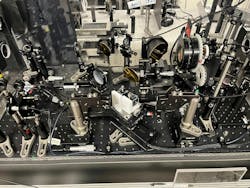Laser light unleashes quantum behavior at room temperature
In a quantum breakthrough, a group of researchers from around the globe—Stockholm University and the Nordic Institute for Theoretical Physics (NORDITA) in Sweden, the University of Connecticut and SLAC National Accelerator Laboratory in the U.S., Japan’s National Institute for Materials Science, and Italy’s Elettra Sincrotrone Trieste, the Sapienza University of Rome, and the Ca’ Foscari University of Venice—are using short, intense laser light to unleash quantum behavior within nonmagnetic materials to make them momentarily magnetic at room temperature.
Their work marks a significant advance because most quantum technologies today rely on extremely cold environments of laboratories. Now, quantum behaviors such as magnetism and superconductivity can potentially make their way to researchers to explore outside of cold laboratories.
Researchers are on a quest to figure out why quantum particles behave the way they do—with their frequently downright mind-bending properties that defy classical laws of physics by turning materials magnetic or superconducting. Gaining a deeper understanding of bizarre quantum states can help to manipulate materials and tap into desirable quantum mechanical properties.
The inspiration for the team’s work sprang from theoretical works “suggesting we could create magnetization in virtually any materials by stirring atoms in circular loops,” says Stefano Bonetti, who led the team and is a faculty member at Stockholm University and at Ca’ Foscari University of Venice. “My background is in magnetism, and during the past few years I started to explore the phonon dynamic because I thought it was a perfect combination to try testing this idea in my lab.”
It's a relatively simple idea: combine a quantum material, strontium titanate (SrTiO3), with an optically active phonon with a laser source resonant with the phonon frequency and circular polarization. “Laser light polarized in this way couples to the phonon and drags the atoms in circular loops,” Bonetti says.
When laser light moves atoms and electrons within the material in a circular motion, it generates currents that make it magnetic. A new far-infrared light source, developed by the team, has a polarization with a corkscrew shape and enables the circular motion.
Their work is the first known to induce and show how SrTiO3 becomes magnetic at room temperature during an experiment. This approach also makes it possible to create magnetic materials out of many insulators—which tend to be made of metals.
How do you induce quantum behavior?
The team opted to use SrTiO3, a material with an infrared active phonon mode and a frequency of approximately 3 THz at room temperature. It requires an intense electric field within the terahertz range to be driven efficiently.
“We achieved such a field by using two down-conversion processes,” Bonetti explains. “The first is from an amplified titanium-sapphire laser lasing at 800 nm, which is converted using an optical parametric amplifier into a 1.5-µm beam.”
The second down-conversion process “involves an organic crystal that rectifies the 1.5-µm wavelength into a broadband 75- to 150-µm pulse,” Bonetti says. “For this broadband pulse, with amplitude exceeding 1 MV/cm, we bandpass filter the 100-µm wavelength (10% bandwidth) to correspond to the 3 THz frequency.”
Finally, the terahertz field is given a circular polarization, courtesy of a quarter-wave plate. “This is the driving field that hits the sample, and probing is done at the reflectivity of the transmissivity of the 800-nm fundamental via a standard pump-probe method,” Bonetti says.
The material turns magnetic “almost immediately after laser excitation, as soon as the atomic motion is induced, with a timescale related to the phonon frequency—in the picosecond range,” Bonetti adds. “The exact mechanism of the enhancement of the magnetic moment is still an open question. There are several hypotheses about what the fundamental mechanism may be, but this will require further experimental and theoretical studies to be fully understood.”
‘Wow’ moment
A big moment for the team was the discovery that the effect they measured was 10,000x larger than predicted by theory. “This was a ‘wow’ moment for us in the lab,” says Bonetti. “It took years to make sure there were no artifacts and to understand how this was possible, but ultimately we found a way and other researchers have now replicated our findings independently.”
This work is truly an interdisciplinary effort between experimentalists and theorists with different expertise. “My group in Stockholm and Venice initiated the project and performed most of the experiments, with crucial independent measurements performed at SLAC National Accelerator Laboratory,” says Bonetti. “The theoretical modeling of dynamical multiferroicity was guided by UConn, with the group in Rome, Italy, contributing to the nonlinear optics description, and the group in Tsukuba, Japan, responsible for the state-of-the-art ab initio calculations to model the material.”
As far as applications go, “it’s always difficult to tell what the applications will be when you’re dealing with fundamental science,” Bonetti says. “Clearly, magnetic data storage technologies can make use of some of our findings here to test new ways of encoding magnetic information.”
It’s now crucial to fully understand what’s happening “from a physics point of view to improve the control over the effect,” says Bonetti. “Contributions from other groups, as well as from other measurements we’ve made in different materials, will help us find the general traits of the physics at play here.”
Their goal is also to make the effect long-lasting—because today the effect is only there when the laser light is present. “From what we observed, this seems to be mostly a matter of identifying the right material, which makes us carefully optimistic that this will be demonstrated within the near future,” Bonetti says.
FURTHER READING
M. Basini et al., Nature, 628, 534–539 (2024); https://doi.org/10.1038/s41586-024-07175-9.
About the Author
Sally Cole Johnson
Editor in Chief
Sally Cole Johnson, Laser Focus World’s editor in chief, is a science and technology journalist who specializes in physics and semiconductors.



